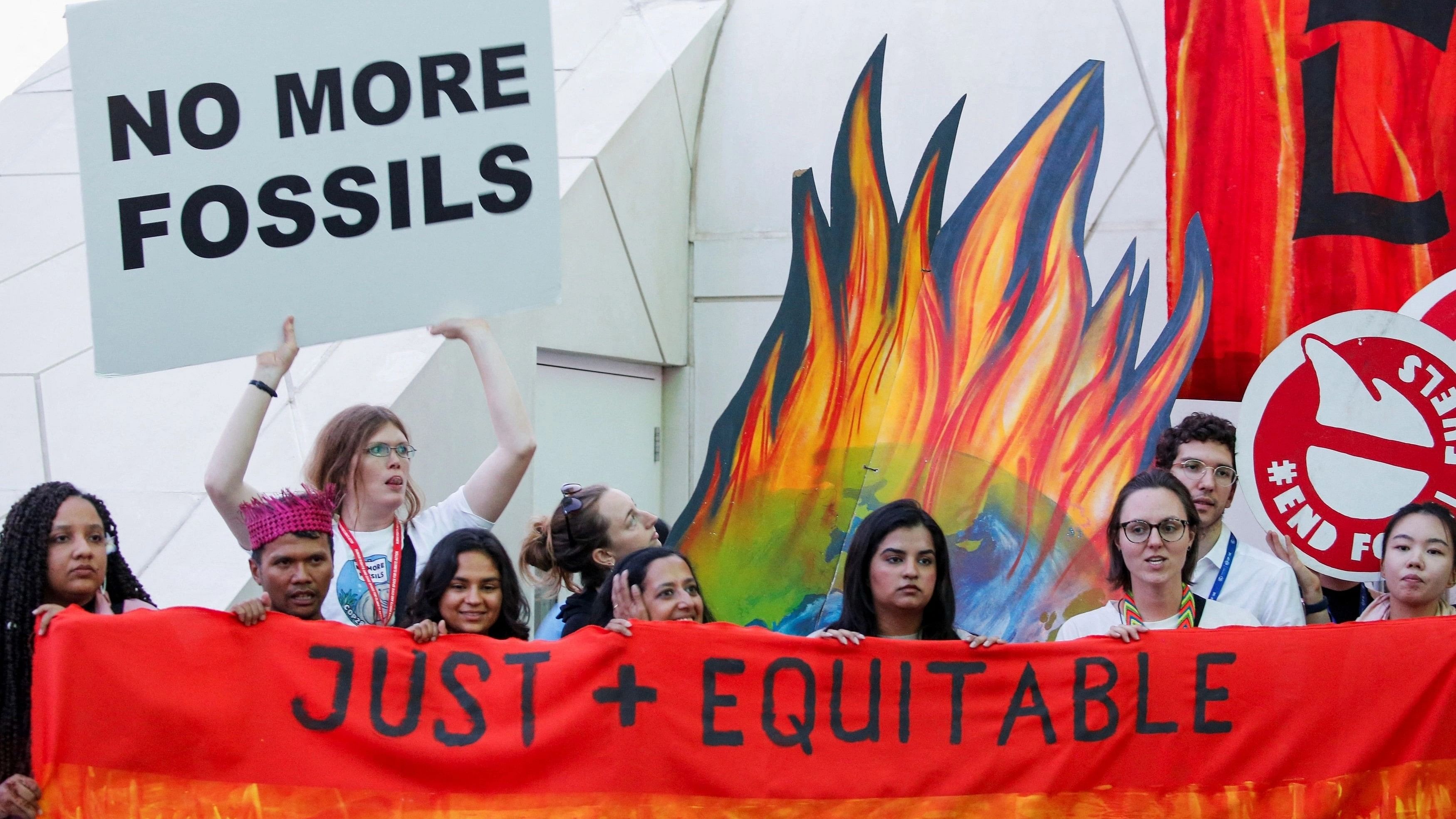
Representative image of a protest against fossil fuels.
Credit: Reuters Photo
The hottest year on record, 2023, highlights India’s obligation to environmental sustainability. Amidst the COP28 summit, India faces a dilemma of high ambitions and contradictions.
The global decision to move away from fossil fuels, though ambiguous, is imperative for India, the third-largest greenhouse gas emitter. Prime Minister Narendra Modi, at the 2023 G20 Meeting on Environment in Chennai, emphasised India’s key role in global environmental efforts.
However, a gap persists between India’s international commitments and domestic policy actions. This article examines
India’s environmental strategies, exposing potential greenwashing and the disparity between ambitious statements and tangible measures.
It contrasts India’s participation in global forums like COP28 and the G20 summit, themed ‘Vasudhaiva Kutumbakam’ against the reality of implementing policies, exploring the intricacies of funding
green initiatives and honouring international promises.
India’s environmental strategy reflects significant commitments. At the 2015 Paris Climate Summit, India committed to reducing its GDP’s emissions intensity by 33-35%, later revised to 45% by 2030, while targeting 40% of electricity from non-fossil sources.
These goals are supported by key initiatives like the National Solar Mission, targeting 100 GW of solar capacity by 2022, and the National Clean Air Programme, which seeks to address air pollution in
over 100 cities.
The Lifestyle for the Environment (LiFE) initiative promotes sustainable living. Union budgets have incorporated initiatives like the Green India Mission for afforestation, the Clean Energy Cess for renewable energy projects, and the National Adaptation Fund for climate change
mitigation. These strategies illustrate
India’s evolving commitment to sustainable development
However, this raises questions about India’s environmental ambitions, revealing complexities and contradictions
that warrant a closer examination of its policy paradox.
Commitment vs. Action
India’s environmental efforts are a complex mix: a shift towards eco-friendly projects, yet hindered by a focus on fossil fuels, skewed priorities and insufficient funds.
The 2022-23 and 2023-24 budgets, emphasising ‘energy transition’ and ‘green growth’, fall short in prioritisation. The 2024-25 budget’s stark contrast of Rs 11,11,111 crore for infrastructure development against Rs 3,265 crore for environmental initiatives highlights this issue, neglecting smaller-scale climate actions. The government’s environmental strategy seems fragmented without a cohesive, long-term plan.
The government’s ‘Ease of Doing Business’ agenda overshadows environmental concerns. PARIVESH, aimed to expedite environmental clearances, casts doubt on the commitment to environmental conservation. This is affirmed by the
2023 Forest (Conservation) Amendment Bill, which permits the use of forest
lands for non-forest purposes, thus endangering biodiversity and indigenous livelihoods.
Driven by economic ambitions, the government views the environmental crisis as an economic opportunity. The 2022-23 budget aligns ‘Energy Transition and Climate Action’ with business ventures, like electric vehicle and battery production, favouring centralised renewable energy over smaller-scale eco-friendly options, serving corporate interests.
References to ‘green growth’ and ‘circular economy’ lacked commitment to conservation.
Budgetary Imbalances
An analysis of India’s budget allocations from 2013-14 to 2024-25 reveals a concerning trend: economic development priorities overshadow environmental conservation. Post the 2015 Paris Climate Summit, the Ministry of Environment, Forests and Climate Change (MOEFCC) has seen a modest average budget increase of only 1.03%.
In contrast, ministries impacting the environment—like road transport and highways, heavy industries, defence, atomic energy, mines, and thermal power—have received substantial budget hikes, averaging increases of 144.54%, 143.89%, 73.34%, 71.66%, 51.20%, and 44.12%, respectively.
Although the Ministry of New and Renewable Energy’s budget has risen by 276.69%, it seems more directed towards meeting energy demands than earnest climate change mitigation.
The Coal Conundrum
Despite reduced funding for the Ministry of Coal, from Rs 498 crore in 2013-14 to Rs 192 crore in 2024-25, coal production is on rise from 778.21 MT to the targeted production of 1012 MT in 2023–24, with 60.51% average growth over a decade.
This growth, along with increased coal imports, questions India’s commitment to reducing coal dependence. Concurrently, the Ministry of Power’s budget has doubled from Rs 10,073 crore to Rs 20,671 crore in the same period, with 25,400 MW of thermal power capacity still under construction.
In 2023, New Zealand, the United States, Germany, and even Kenya allocated 1.3%, 0.28%, 0.90%, and 0.20% of their budgets, respectively, towards environmental
protection, while China committed a substantial 2.56%.
In stark contrast, India trailed with a mere 0.06% allocation, despite its environmental pledges. This discrepancy is evident in India’s budgetary allocations: while
ministries impacting the environment receive substantial funding, the primary ministry responsible for environmental stewardship is notably underfunded. This pattern reflects India’s inclination to prioritise other sectors over pressing environmental concerns.
Recommendations
Given India’s stark inconsistencies in environmental policy and budgeting, an urgent shift from a development-centric to an environment-centric approach is essential.
While promoting solar energy, EVs, and other technical solutions is positive, protecting forests, preserving biodiversity, conserving energy, and modifying lifestyles are crucial to combat climate change.
Regulatory frameworks must be fortified with stringent penalties for environmental violations, and the ‘Ease of Doing Business’ index should incorporate sustainability metrics. Prioritising climate education nationally will cultivate urgency and promote green practices among citizens.
In conclusion, a review of India’s green policies and budget allocations reveals a significant gap between its international environmental rhetoric and domestic actions. Despite PM Modi’s commitments at COP 28 for sustainable development and substantial emission reductions by 2070, there remains a notable discrepancy in national implementation.
The country needs to transition from mere declarations to actual, holistic environmental strategies and concrete steps.
Fulfilling the Paris Agreement commitments is vital not only for ecological balance but also for socio-economic progress. As India fortifies its global environmental stance, it’s crucial to align international promises with domestic policies for a lasting environmental legacy. The urgency of this action is paramount, bearing significant consequences for future generations.
(The author is a research scholar at Christ (Deemed to be University),
Bengaluru)